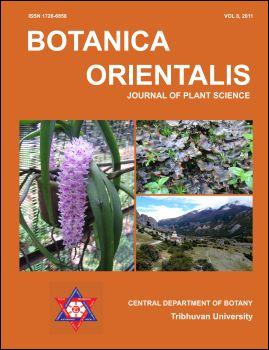Terricolous lichens as indicator of anthropogenic disturbances in a high altitude grassland in Garhwal (Western Himalaya), India
DOI:
https://doi.org/10.3126/botor.v8i0.5554Keywords:
anthropogenic impact, Garhwal Himalaya, grazing, lichens diversityAbstract
Lichens are known to be more sensitive indicators of ecosystem functioning and disturbances than any other cryptogams and vascular plant communities. Himalayan habitats, despite their stressed climates, harbor some of the unique biodiversity of the region, vital for overall ecosystem functioning and stability. Lichens, due to their desiccation tolerance, are able to survive in high altitude habitats and evolved into diverse categories and functional groups. Present study examines the terricolous lichen community in Chopta-Tungnath temperate-alpine grassland of Garhwal Himalaya, in order to identify potential elements (species/growth form) as indicator of anthropogenic disturbances. Terricolous lichens were sampled from twelve sites distributed in three stratified macrohabitats, along increasing altitudinal gradient. A total of twenty soil lichen species belonging to ten genera, six families and four morphological groups (i.e. leprose, foliose, dimorphic and fruticose) were identified. Terricolous lichen diversity was negatively correlated (r = 0.70; p<0.05) with altitude. Among the four growth forms, fruticose growth form was indicator of grazing disturbance, distinguishing low grazed high altitude (3400-4001 m asl) areas with highly grazed low altitude (2700-3000 m asl) to mid altitude (3000-3400 m asl) areas. Terricolous lichen diversity in the study area was found constrained by vascular plants at lower altitudes, human-related impacts (tourism and livestock grazing induced trampling) at mid-altitudes and habitat characteristics (low soil cover) at higher altitudes.
doi: http://dx.doi.org/10.3126/botor.v8i0.5554
Botanica Orientalis – Journal of Plant Science (2011) 8: 16-23
Downloads
Downloads
Published
How to Cite
Issue
Section
License
This license enables reusers to copy and distribute the material in any medium or format in unadapted form only, for noncommercial purposes only, and only so long as attribution is given to the creator.




